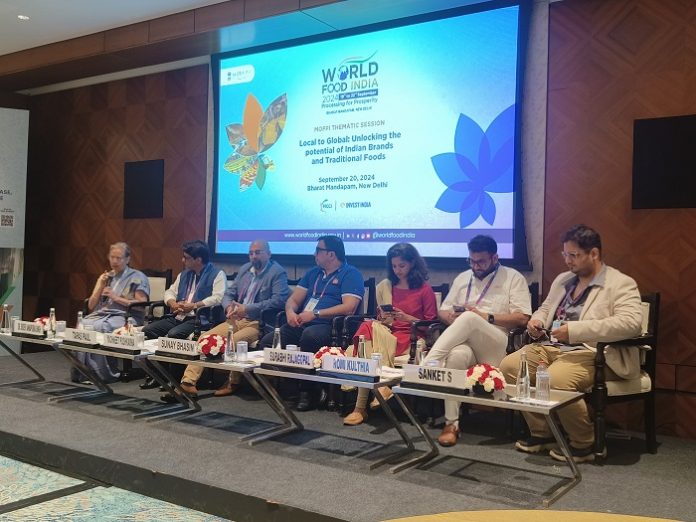
One of the sessions at the recent World Food India conference in Pragati Maidan, New Delhi, focused on unlocking the potential of Indian brands and traditional foods and how Indian cuisine can go from local to global.
Dr Sridevi Annapurna Singh, director, CFTRI, Mysuru, who was moderating the session, said Indian food is the fourth most popular cuisine all over the world and 80% of Indians preferred to have Indian food owing to its warm nature, indigenous spice mixes and seasonally available items. The driving factors behind this are primarily the cost and price.
Despite these facts, India is among the top three food raw material suppliers and is not much into supplying processed food items, she said, adding the major challenges include different varieties of food produced, the shelf life of food products and grains and food safety issues as well as transport, storage, and labeling of Indian food products.
Yachneet Pushkarna – chief executive officer and managing director – HariBol Dairy Products by Iskcon, said the brand is well known due to its presence across the world and its Govinda’s restaurant, which serves sattvik Indian food. He said Iskcon is trying to collaborate with AI technology from the US and IITs to foster transparency and assurance by bringing IoT devices to farmers. Though the HariBol brand is just over two years old, it has featured in the World Economic Forum in faith and action as one of the top four brands out of a list of 200 startups for its cruelty-free dairy farming practices.
Tapas Paul, lead environment specialist Environment, Natural Resources & Blue Economy Global Practice, World Bank, said we don’t value our own food despite being world leaders in sweets and namkeen exports. There should be more Delhi Haat type of Indian food pavilions in all states and district headquarters to expand the range of regional food products. He took the example of Puranpoli from Maharashtra, which is not available in states such as Bihar and Assam. These food pavilions need to have the best recipes, the best chefs and top-class ingredients.
India should diversify its forest products, which is one of its strengths, he said, adding though insects are popular foods in certain northeastern states, they feature nowhere in the global food market for insects. Paul spoke about gurukools, where students had to collect local ingredients from the forests, which were then converted to food items for consumption.
There is a need to think about quality and food safety as a brand, he said, adding unless we have unadulterated food, India will not be able to develop its food exports. Food testing measures should, thus, be made available free of cost. He said India supports not only the largest human population but also the largest cattle population. He suggested a people’s food register similar to the people’s biodiversity register.
Sunay Bhasin, chief executive officer, MTR Foods, echoed Singh’s opening remark that India is still playing largely at the ingredient and commodity level and that to make Indian food global we need to have a larger vision. Food doesn’t satisfy just your stomach, it has to appeal to your heart, he said, adding taste is of paramount importance in any food product. He said food is always evolving and never static and different migrations, cultures, and rulers India has been exposed to have shaped Indian food in multifarious ways. He took the example of chillis, potatoes, onions and tomatoes, which have a huge influence on Indian food but are not native to the Indian subcontinent.
Reimagination starts from understanding consumer needs, Bhasin said, adding a single brand can’t satisfy all consumer palettes. He said recipes need to be made relevant for today. An ecosystem needs to start to develop traceability of ingredients in such a scale that both farmers and consumers benefit from it, he said, while stressing this requires a large effort between the government and the social sector.
Surabhi Rajagopal, senior program manager, Selco Foundation, said we need to focus on empowering rural producers for value chain enhancement. Strengthening the local supply chain at the level of the micro-entrepreneur addresses shocks such as the Covid-19 pandemic and cyclones in Orissa. At the farm level, solar-powered units for dry fodder can be used to reduce drudgery in farm labor. Additionally, we should enable decentralized processing, decentralized storage and decentralized transportation.
Sanket S, founder, Scandalous Foods, said there should be more automation in food processing with a special focus on research and development for equipment specialized for Indian food products. He said while chicken tikka masala and idli have become national food items rather than just regional foods, we should focus on popularizing more regional foods. Indianization of many global foods such as pizza and pasta is also a trend that is on the rise. Despite its popularity, marketing and branding of Indian food in the global food market remains a challenge, he said.
IndiFoodBev — authentic, impactful and influential
An English-language food and beverage processing and packaging industry B2B platform in print and web, IndiFoodBev is in its third year of publication. It is said that the Indian food and beverage industries represent approximately US$ 900 billion in revenues which implies more than 20% of the country’s GDP. Eliminating the wastage on the farmside can help to deliver more protein to a higher number of the population apart from generating sizable exports. The savings in soil, seeds, water, fertilizer, energy and ultimately food and nutrition could be the most immense contribution that country is poised to make to the moderation of climate change.
To improve your marketing and grow sales to the food and beverage processing and packaging industry, talk to us. Our research and consulting company IppStar [www.ippstar.org] can assess your potential and addressable markets in light of the competition. We can discuss marketing, communication, and sales strategies for market entry and growth.
Suppliers and service providers with a strategy and budget for targeted marketing can discuss using our hybrid print, web, video, and social media channels to create brand recognition linked to market relevance. Our technical writers are ready to meet you and your customers for content.
The second largest producer of fruit and vegetables in the world is continuously expanding processing capacities and delivery systems with appropriate innovative technologies. We cover product and consumer trends, nutrition, processing, research, equipment and packaging from farm to thali. Get our 2025 media kit and recalibrate your role in this dynamic market. Enhance your visibility and relevance to existing markets and turn potential customers into conversations. Ask for a sample copy of our bi-monthly in print or our weekly IndiFoodBev eZine each Wednesday.
For editorial info@ippgroup.in — for advertisement ads1@ippgroup.in and for subscriptions subscription@ippgroup.in
Naresh Khanna – 10 February 2025
Subscribe Now











